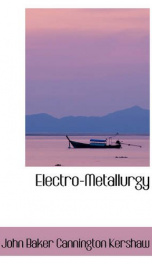electro metallurgy

Purchase of this book includes free trial access to www.million-books.com where you can read more than a million books for free. This is an OCR edition with typos. Excerpt from book: III. Details Of Processes And Works. The Cowles Process.The Cowles process of aluminium production, which was worked upon a fairly large scale in England and America during the early days of the industry, depended upon the reducing action of carbon upon alumina (Al20a) at a red heat. The process was electrothermal and not electrolytic in character, the electric current being employed merely as a heating agent. The reduction of alumina by carbon alone is not possible in the absence .", f :U:v-?A;yo:-v/-fe-rg-.!--- Fig. 1.Cowles aluminium furnace. of any metal with which the aluminium when reduced can alloy itself, for aluminium at all temperatures has a greater affinity than carbon for oxygen. But in the presence of copper or iron, the reduction of alumina by carbon is practicable in the electric furnace, since the affinity of the two metals and disposition to form an alloy renders the aluminium more ready to part with its oxygen. The Cowles process as worked at Milton, in Staffordshire, consisted in heating powdered corundum (a form of alumina, AlaOa) with charcoal and iron filings in a largeelectric furnace (Fig. 1). Charcoal coated with lime was used as lining for the furnace. A current of 5,000 amperes at 60 volts was employed for heating the furnace, and one and a half hours was required for reducing each charge. The yield was stated to be 1 lb of alloy per 18 e.h.p. hours. The dynamo used at Milton for supplying the electric current to the Cowles furnace was of 300 k.w. capacity, and at the date of this trial (1888) it was the largest generator yet built in any country. It was visited and inspected by many engineers as a notable triumph in electrical engineering work. As 5,000 and 7,500 k.w. generators are now common, the Milton dynamo serves only to mark ...
Info about the book
Author:
Series:
Unknown
ISBN:
1234457482
Rating:
3/5 (3)Your rating:
0/5
Languge:
English
Users who have this book
Users who want this book
What readers are saying
What do you think? Write your own comment on this book!
write a commentif you like electro metallurgy try:
Other books by this author
Do you want to exchange books? It’s EASY!
Get registered and find other users who want to give their favourite books to good hands!


